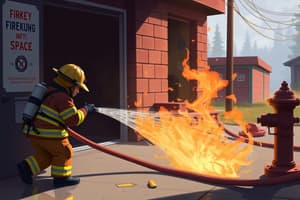Podcast
Questions and Answers
When would a 3" hose be used instead of a 5" hose for a forward lay?
When would a 3" hose be used instead of a 5" hose for a forward lay?
- When the IC requests it.
- When only a small amount of water is needed.
- When the flow capabilities are sufficient. (correct)
- When there is a greater risk of fire.
What is mandatory when completing a forward lay of 5" hose?
What is mandatory when completing a forward lay of 5" hose?
- Using only two firefighters.
- Employing a four-way valve and a 5" hose manifold. (correct)
- Utilizing multiple hydrants simultaneously.
- Employing a hose reel setup.
What role is assigned to the firefighter behind the driver/operator (D/O) during suppression operations?
What role is assigned to the firefighter behind the driver/operator (D/O) during suppression operations?
- Nozzle Firefighter
- Hydrant Firefighter (correct)
- Unit Officer-in-Charge (OIC)
- Safety Engineer
What action should be prioritized for charging supply lines when possible?
What action should be prioritized for charging supply lines when possible?
Which supply line layout method is not mentioned as one of the three methods?
Which supply line layout method is not mentioned as one of the three methods?
Who holds the responsibility to review and update the supply line procedure?
Who holds the responsibility to review and update the supply line procedure?
In what scenario would visual signals be used to communicate with hydrants?
In what scenario would visual signals be used to communicate with hydrants?
What is a key characteristic of a split lay method in water supply evolution?
What is a key characteristic of a split lay method in water supply evolution?
What is the primary purpose of connecting a double female coupling at the hydrant?
What is the primary purpose of connecting a double female coupling at the hydrant?
Which safety procedure is essential before opening the hydrant after confirming connections?
Which safety procedure is essential before opening the hydrant after confirming connections?
What is the recommended action if the Fire Department Connection (FDC) is not usable?
What is the recommended action if the Fire Department Connection (FDC) is not usable?
During the operation, what should be done to ensure optimal pressure monitoring?
During the operation, what should be done to ensure optimal pressure monitoring?
Which of the following equipment is NOT listed as part of the minimum inventory for the hydrant bag?
Which of the following equipment is NOT listed as part of the minimum inventory for the hydrant bag?
What is the result of incorrectly turning the handle on the hydra-assist?
What is the result of incorrectly turning the handle on the hydra-assist?
What should the #1 Unit OIC do after supplying another apparatus?
What should the #1 Unit OIC do after supplying another apparatus?
Why should longer sections of 5" hose be avoided in the setup?
Why should longer sections of 5" hose be avoided in the setup?
Which step should be performed first when using the hydra-assist to boost pressure?
Which step should be performed first when using the hydra-assist to boost pressure?
Which position assists in connecting the supply hose to the portable hydrant?
Which position assists in connecting the supply hose to the portable hydrant?
What is a critical first step for the Hydrant FF after the order to open the hydrant?
What is a critical first step for the Hydrant FF after the order to open the hydrant?
What is the essential reason for using a gated wye during hydrant operations?
What is the essential reason for using a gated wye during hydrant operations?
Why is a rubber mallet included in the hydrant bag inventory?
Why is a rubber mallet included in the hydrant bag inventory?
What should be done after confirming that all valves on the portable hydrant are shut?
What should be done after confirming that all valves on the portable hydrant are shut?
What is the primary role of the supply apparatus in a hose lay evolution?
What is the primary role of the supply apparatus in a hose lay evolution?
What should the hydrant firefighter do after checking the hydrant for serviceability?
What should the hydrant firefighter do after checking the hydrant for serviceability?
What is the maximum speed at which the driver operator should operate during a forward hose lay?
What is the maximum speed at which the driver operator should operate during a forward hose lay?
What is the first step for the Nozzle firefighter before deploying an attack line?
What is the first step for the Nozzle firefighter before deploying an attack line?
Which action is NOT required when the hydrant firefighter opens the hydrant?
Which action is NOT required when the hydrant firefighter opens the hydrant?
For a forward lay of 3” hose, which statement is true?
For a forward lay of 3” hose, which statement is true?
Which firefighter is responsible for connecting the supply hose to the portable hydrant?
Which firefighter is responsible for connecting the supply hose to the portable hydrant?
What should occur if there are any burst hose lengths during operation?
What should occur if there are any burst hose lengths during operation?
What action must the Hydrant firefighter ensure when signal #2 proceeds with the forward lay?
What action must the Hydrant firefighter ensure when signal #2 proceeds with the forward lay?
Flashcards are hidden until you start studying
Study Notes
Forward Lay Supply Line Evolutions
- Forward lay will primarily use 5” hose unless the Incident Commander (IC) specifies 3" hose for specific flow needs.
- Use of a hydra-assist (four-way valve) and 5” hose manifold (portable hydrant) is mandatory for 5” hose lays.
- Radio communication is the preferred method for charging supply lines; alternative visual signals are a backup option.
Riding Positions and Responsibilities
- Designated riding positions on the suppression apparatus:
- Unit Officer-in-Charge (OIC)
- Driver/Operator (D/O)
- Hydrant Firefighter (behind D/O)
- Nozzle Firefighter (behind OIC)
- No personnel allowed to ride on tailboards of Miami-Dade Fire Rescue (MDFR) apparatus.
Types of Hose Lays
- Forward lays are one of three methods to lay supply lines, alongside reverse and split lays, chosen based on situational needs.
Definitions
- Attack Apparatus: Used to fight fires on the scene.
- Split Lay: Involves two apparatus to establish a single supply line.
- Supply Apparatus: Provides water supply to the attack apparatus.
Conducting a Single 5" Hose Forward Lay
-
At the Hydrant:
- OIC orders and supervises the 5” hose lay.
- D/O positions apparatus and awaits signals.
- Hydrant FF checks hydrant serviceability and flows sufficient water.
- Nozzle FF prepares hose, ensuring no excess obstructs the road.
- Hydrant FF secures hose at the hydrant, signals D/O to proceed.
- D/O drives at max 10 mph, maintaining road access.
- Nozzle FF follows, ensures couplings remain connected, and counts sections.
- Hydrant FF connects hydra-assist to hydrant and awaits radio order to open it.
-
At the Fire Scene:
- OIC determines apparatus spot and evaluates hose needs.
- D/O engages pump and prepares to supply attack lines.
- Nozzle FF disconnects hose and connects to the portable hydrant.
- Hydrant FF polices lines and awaits further assignment.
Forward Lay of 3” Hose
- Used only when determined adequate for supply needs, with IC approval.
- 3” lines typically hand-laid, connecting directly to hydrant discharges and auxiliary intakes, without hydra-assist.
Supplying Another Apparatus
- OIC positions the apparatus to optimize hose lengths; D/O assists in hydrant connections and communication.
- Nozzle FF connects to portable hydrant and reports lengths laid.
Supplying a Fire Department Connection (FDC)
- OIC assesses FDC location and serviceability, planning hose deployment.
- D/O and Nozzle FF connect hose from the portable hydrant to FDC.
Boosting Pressure in a Supply Line Using Hydra-Assist
- Crew can perform boosting of pressure, positioning apparatus close to hydrant.
- Specific connections made from hydra-assist to pump intake and discharge valves.
- Monitor residual pressures to avoid apparatus cavitation during boosting.
Hydrant Bag Minimum Equipment Inventory
- Hydrant bags must include:
- Combination locking and regular hydrant wrench
- Two 2-½” caps and spanner wrenches
- Two 5” spanner wrenches
- One rubber mallet
- One Florida East Coast (FEC) adaptor
- Regular checks of equipment are required daily.
Studying That Suits You
Use AI to generate personalized quizzes and flashcards to suit your learning preferences.




